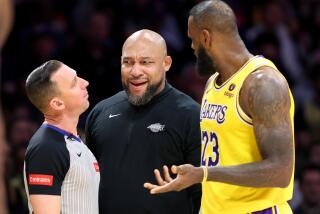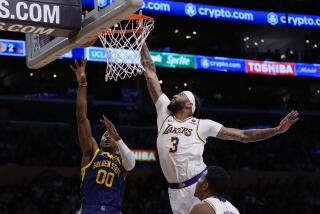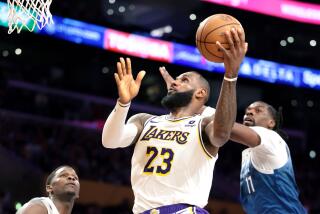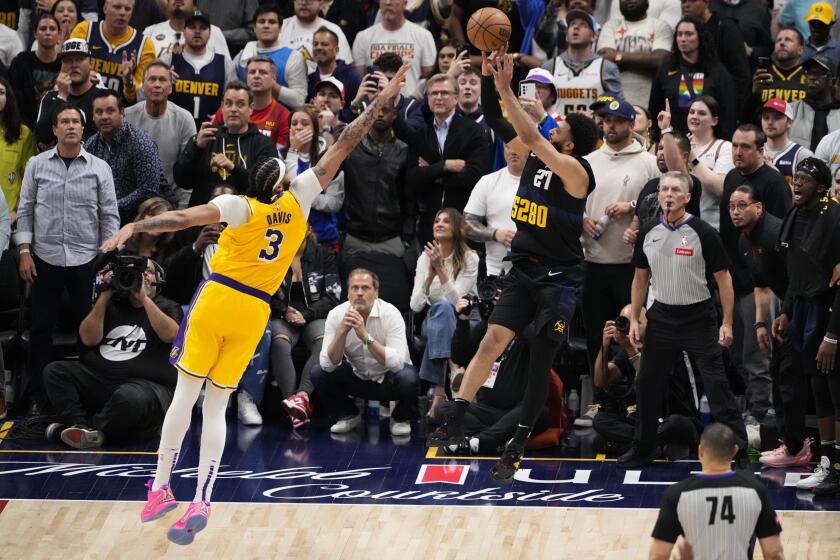When it comes to rules, sometimes they play the odds
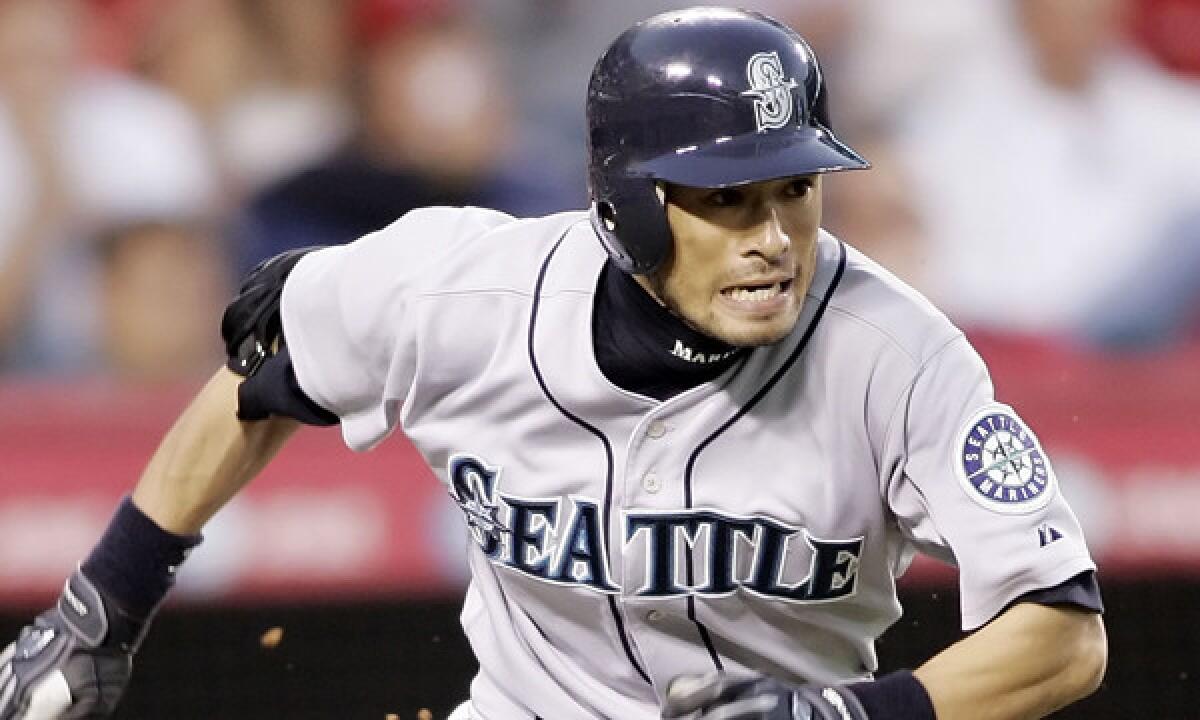
The Lakers were down to five healthy and eligible players Wednesday night when center Robert Sacre picked up his sixth personal foul, fueling hope for a struggling Cleveland team that it would play the final 31/2 minutes with a man advantage.
It was merely a Sacre-tease.
An obscure NBA rule requiring each team to have five players on the floor nullified a Cavaliers power play. Sacre, though penalized with a technical foul, was allowed to remain in the game, and the Lakers won, 119-108.
Some of sports’ most head-scratching moments stem from rules that are rarely applied, and plenty of managers, coaches and players have experienced the kind of confusion that surrounded the end of the Lakers-Cavaliers game.
Angels Manager Mike Scioscia is a rules expert who is rarely puzzled by the most convoluted of plays, but he was admittedly stumped during a game against Seattle a few years ago.
Caught in a rundown between second and third, the Mariners’ Ichiro Suzuki bolted toward the outfield grass, where the shortstop normally plays, and back toward the infield grass, a zig-zag that seemed in clear violation of a rule requiring him to be within three feet of the basepath.
But Suzuki was not ruled out immediately, giving a trailing runner ample time to advance to second base.
The reason umpires allowed Suzuki’s serpentine route can be found in Rule 7.08 (a), which states a basepath is established “when the tag attempt occurs,” and that a runner is out when he runs more than three feet away from his basepath “to avoid being tagged.”
“Everyone assumes if you’re out of the baseline, you’re out,” Scioscia said. “But the umpires said you can run wherever you want until the tag is being made. I lost that argument, but we still have that play on tape. We use it as a training tool.”
A look at some other strange-but-true rules from the four major sports:
Through the wickets
Denver fans are still reeling over the botched snap that went over quarterback Peyton Manning’s head and into the end zone for a safety that gave Seattle a 2-0 lead on the first play of the Super Bowl.
Had Manning been under center instead of in the shotgun formation, the safety could have been avoided. Under a seldom-invoked rule, a snap that goes through a quarterback’s legs but is never touched by him is a dead ball.
The situation unfolded in a 2007 NFL game between Chicago and Philadelphia. Bears center Olin Kreutz snapped a ball that went through quarterback Brian Griese’s legs. Eagles safety Sean Considine recovered, seemingly putting his team in position to take the lead.
But because Griese never touched the ball, referee Ed Hochuli called the play dead and penalized Chicago for a false start. The Bears went on to win, 16-9.
Fourth out required
A team has the bases loaded with one out, the manager calls for a suicide squeeze, and the bunt is popped up. The first baseman catches the ball and, after the runner sprinting home crosses the plate, tags first for a double play. The inning is over and the run doesn’t count, right?
Wrong. Under baseball rules, the defensive team would have to appeal the play at third and tag the third-base bag before that runner is ruled out. If all nine fielders head to the dugout and cross the foul line, the inning is considered dead. The defensive team forfeits its right to appeal, and the run would count.
“We call it the fourth-out-of-an-inning rule,” Scioscia said. “You have to be cognizant of the fact that if the runner scores before first base is tagged for the third out, then that run counts until you go tag third base.”
Wrong-way Nate
In a 2009 game between New Jersey and New York, Knicks guard Nate Robinson took an inbounds pass in the backcourt with 0.5 seconds left in the first quarter and, on a whim, fired a shot toward his own basket that went in for an apparent three-pointer.
Though time expired before the shot, Robinson took all kinds of heat from then-Knicks Coach Mike D’Antoni and broadcaster Marv Albert.
“That is a ridiculous move,” Albert said. “He thought time had run out, but you never know. I don’t know if he was confused as to which direction he was going.”
But even if time hadn’t expired, the shot would not have counted for the Nets. Under NBA rules, a player cannot score on his own team unless on accident.
For example, if a basket is made on a tip during a fight for a rebound, the points are credited to the closest offensive player.
Had Robinson’s shot been made within regulation time, the play would have been ruled a turnover, the ball going to the Nets without a change of score.
Blades of infamy
Few Southern California fans knew of an NHL rule restricting the curvature of a hockey stick’s blade to three-quarters of an inch until Kings defenseman Marty McSorley was penalized at a most inopportune time.
The Kings won the first game of the 1993 Stanley Cup Finals and had a 2-1 lead over Montreal with two minutes left in Game 2 when Canadiens Coach Jacques Demers asked that the curve of McSorley’s stick be measured.
The stick was deemed illegal, McSorley went to the penalty box, and Montreal scored on the ensuing power play to send the game to overtime, where Eric Desjardins beat Kings goalie Kelly Hrudey for the game winner. The Canadiens went on to win the series in five games.
Just for kicks
Though it has been 37 years since it was last used successfully, the fair catch kick rule still exists in the NFL.
The rule allows a team that has made a fair catch to take a free kick — uncontested by the defense — at the goal posts. The kicking team may not use a tee. The ball must be placed or drop-kicked.
A successful kick is awarded three points. The last converted fair catch kick was a 45-yarder by San Diego’s Ray Wersching against Buffalo in 1976. Perhaps the most famous one was Mac Percival’s 43-yarder with 20 seconds left that gave the Chicago Bears a 13-10 win over Green Bay in 1968.
San Francisco’s Phil Dawson fell short on a 71-yard attempt against St. Louis last September, and Arizona’s Neil Rackers (68 yards) and Green Bay’s Mason Crosby (69 yards) fell short on 2008 attempts.
Obstruction is justice
In one of the most bizarre endings in World Series history, St. Louis defeated Boston in Game 3 last October on an obstruction call that allowed the winning run to score.
Cardinals runner Allen Craig tripped over Red Sox third baseman Will Middlebrooks while trying to score on an errant throw into left field.
Left fielder Daniel Nava’s throw beat Craig to the plate, but umpire Jim Joyce ruled correctly that Middlebrooks, who remained on the ground in the third-base line, had obstructed Craig.
According to Rule 2.00, “After a fielder attempts to field a ball and misses, he can no longer be in the act of fielding. For example: an infielder dives for a grounder and the ball passes him and he continues to lie on the ground and delays the progress of a runner. He very likely has obstructed the runner.”
Faked ‘em out, temporarily
In one of the more hotly protested games in NBA history, Lakers guard Norm Nixon faked the second of two free throws with his team down by two points and three seconds left against San Antonio in December of 1982.
Players from both teams were drawn off their lines, resulting in a double lane violation.
Officials called for a tipoff at center court, which the Lakers won, and Nixon scored to force overtime.
The Lakers won in double overtime, but the Spurs filed a protest, arguing that Nixon should have been forced to take the second free throw.
The league agreed, the Spurs won when the last three seconds were replayed when the teams met later in the season. The NBA rule book now states that “the free-throw shooter shall not purposely fake a free-throw attempt.”
The ultimate no-show
A quick scan of the NHL rule book leaves you with this thought: These guys think of everything. There are several guidelines to follow if a referee or linesman has to leave the ice because of injury, and then there is this gem:
“If, through misadventure or sickness, the referees and linesmen appointed are prevented from appearing, the NHL will make every attempt to find suitable replacement officials; otherwise, the coaches of the two clubs shall agree on referees and linesmen.
“If they are unable to agree, they shall appoint a player from each side who shall act as referee and linesman, the player from the home club acting as referee and the player from the visiting club as linesman.”
More to Read
All things Lakers, all the time.
Get all the Lakers news you need in Dan Woike's weekly newsletter.
You may occasionally receive promotional content from the Los Angeles Times.
